VMworld 2017 Europe Conference. Day 2, 3
We continue to talk about the most interesting at VMworld 2017 Europe. If you missed the previous reports, you can read first about the zero and first day of the conference.

Before proceeding to the description of the exhibition of partner solutions, I want to list the main announcements that were made during the conference VMworld US and Europe.
The release of VMware Workstation 14 and VMware Workstation Player 14, client hypervisors installed on top of Windows or Linux.
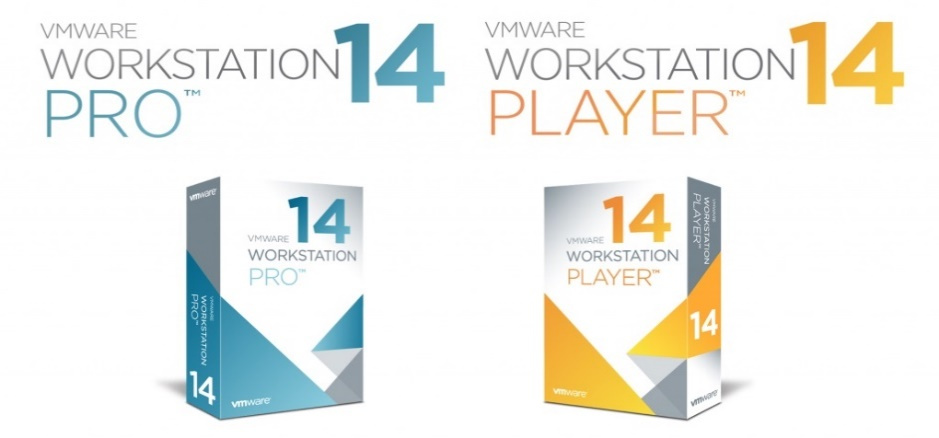
Among the new features:
It is announced that the next version of vSphere (probably vSphere 7.0) will be the last with support for VMware vCenter Server on the Windows platform. The solution is correct and expected, because the functionality of VCSA and vCenter Server for Windows were equal in vSphere 6.0, and in vSphere 6.5, VCSA introduced additional features like the built-in vCenter High Availability mechanism, built-in backup, and vSphere Update Manager update module.
Also, the next version of vSphere will be the last for the vSphere Web Client (Flash-based), which will be replaced by vSphere Client (HTML5).
Last in the drop-out list is vmkLinux, a component that provides ESXi compatibility with Linux drivers. Starting with vSphere 5.5, developers began to provide the so-called native drivers, which provide better performance and stability compared to Linux-drivers. Rejecting vmkLinux potentially means shortening the HCL list of supported servers and peripherals and not being able to run ESXi on your favorite whitebox server with Realtek network adapters.
New release of VMware Integrated OpenStack 4.0.

VIO is an OpenStack distribution developed and maintained by VMware. VIO 4.0 is based on the OpenStack Ocata release and offers the following innovations:
Unfortunately, VIO 3.1 was the latest version to be provided free of charge to customers who purchased vSphere Enterprise Plus. Starting with VIO 4.0, you need to purchase licenses and SnS support for each socket of virtualization servers that will be managed by VIO.
VMware Introduces New Virtual Environment Security Product - AppDefense.
AppDefense allows you to analyze the behavior of applications (processes) running in the guest OS inside the VM, and based on the data received, set a certain baseline - normal behavior for the VM. In case of deviation from the line of behavior, for example, during the actions of malicious software, AppDefense can automatically apply one of the following actions to the VM:
AppDefense can integrate with third-party information security products, such as: IBM Security, RSA, Carbon Black, SecureWorks, expanding the functionality of AppDefense to verify and perform various actions.
A new version of vRNI 3.5, a product for solving problems with virtual and physical network infrastructures, has been released. vRNI collects configuration information from virtual and physical switches, routers, and firewalls and provides it in a convenient, visual format that makes it easier to detect network problems. For example, you can trace the entire path of the packet from the VM network interface — through the NSX logical switch, ESXi server uplink, Cisco Nexus switch port, Juniper router, Check Point ITU — to the physical server port.

The following features appeared in the new version of vRNI: checking the network infrastructure for compliance with the PCI DSS standard, support for collecting data from NSX through the IPFIX mechanism, visualizing traffic between VMs passing through routers with ECMP configured, collecting data from additional third-party sources: Check Point Firewall, HP One View, Brocade MLX.
VMware has updated VIC to version 1.2, which allows containers to run directly on VMware ESXi servers.
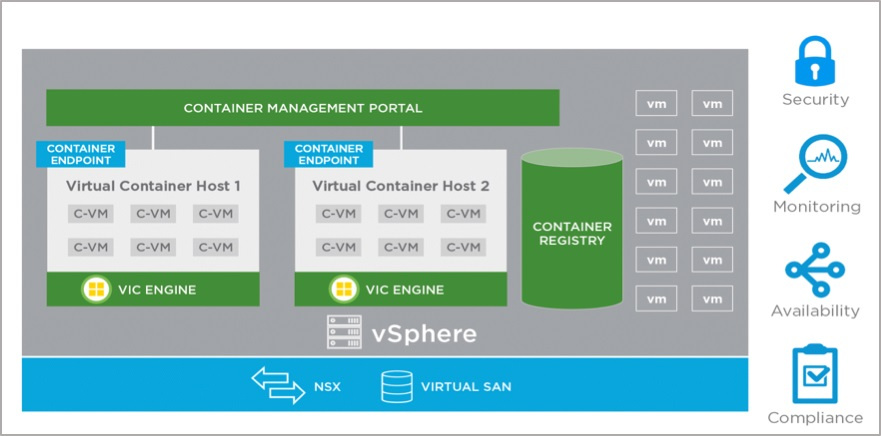
The main difference between the VMware approach and other container managers is that each container runs in a separate instance of the VM. Thus, administrators are able to manage containers in the same way as VMs, using the benefits of a virtualization platform such as better isolation, the ability to move containers from host to host, control container network connectivity using VMware NSX, monitor containers using vRealize Operations Manager, and much more. . To reduce the overhead of launching containers, Instant Clone technology is used, which allows you to create copies of working VMs in real time using the Transparent Pages Sharing and Linked Clones mechanisms to save RAM and disk space.
Among the innovations:
VMware announced a new version of vRealize Suite 2017, which included products such as vRealize Automation 7.3, vRealize Business 7.3, vRealize Operationss 6.6, as well as a new product - vRealize LifeCycle Manager.
Those with experience deploying vRealize Suite know this is not easy. vRealize LifeCycle Manager solves the problems of deploying and updating the above products with just the click of a button, and also allows you to check existing installations for compliance with the best practices of the vendor.
During the conference on the exhibition, excursions were arranged for visitors from Russia and the CIS countries. Evgeny Garbuzov (pictured left), a systems engineer from the VMware branch in Russia, showed the most interesting stands and answered all kinds of tricky questions.

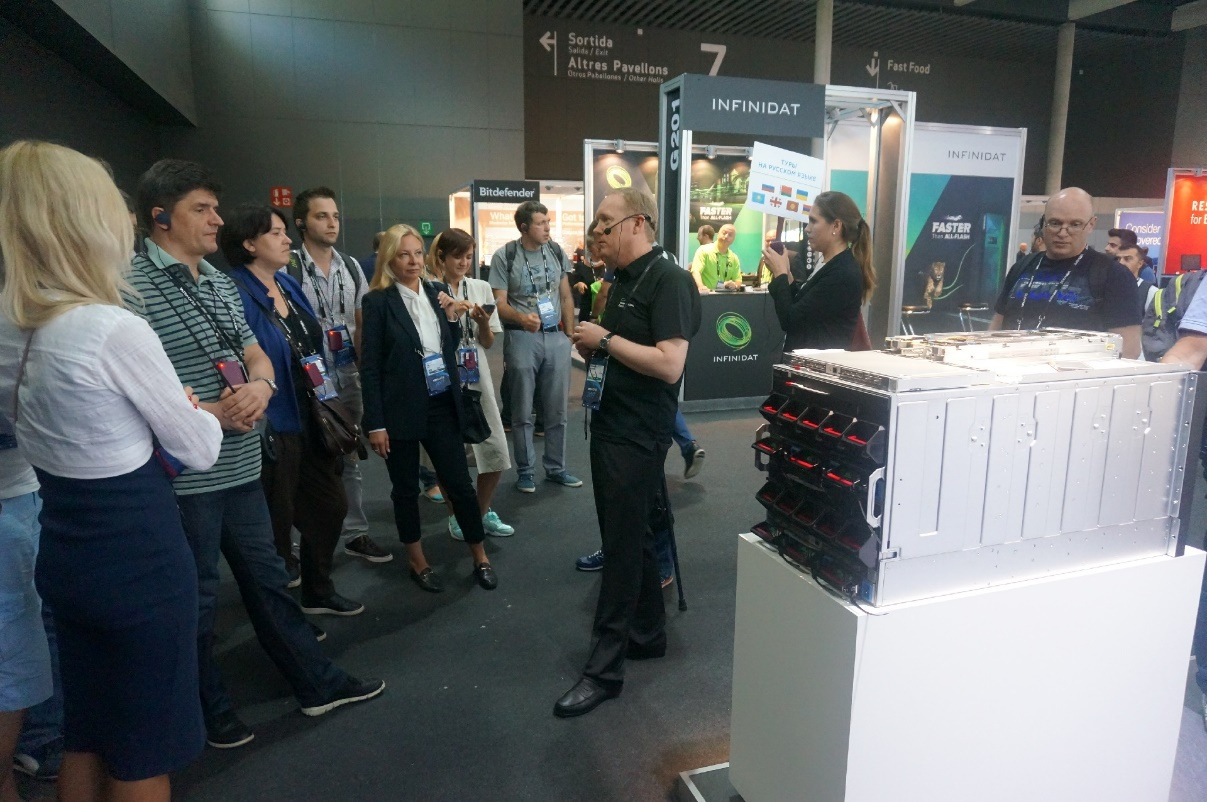
At the NVIDIA booth, accelerators of the Maxwell and Pascal generations were demonstrated.
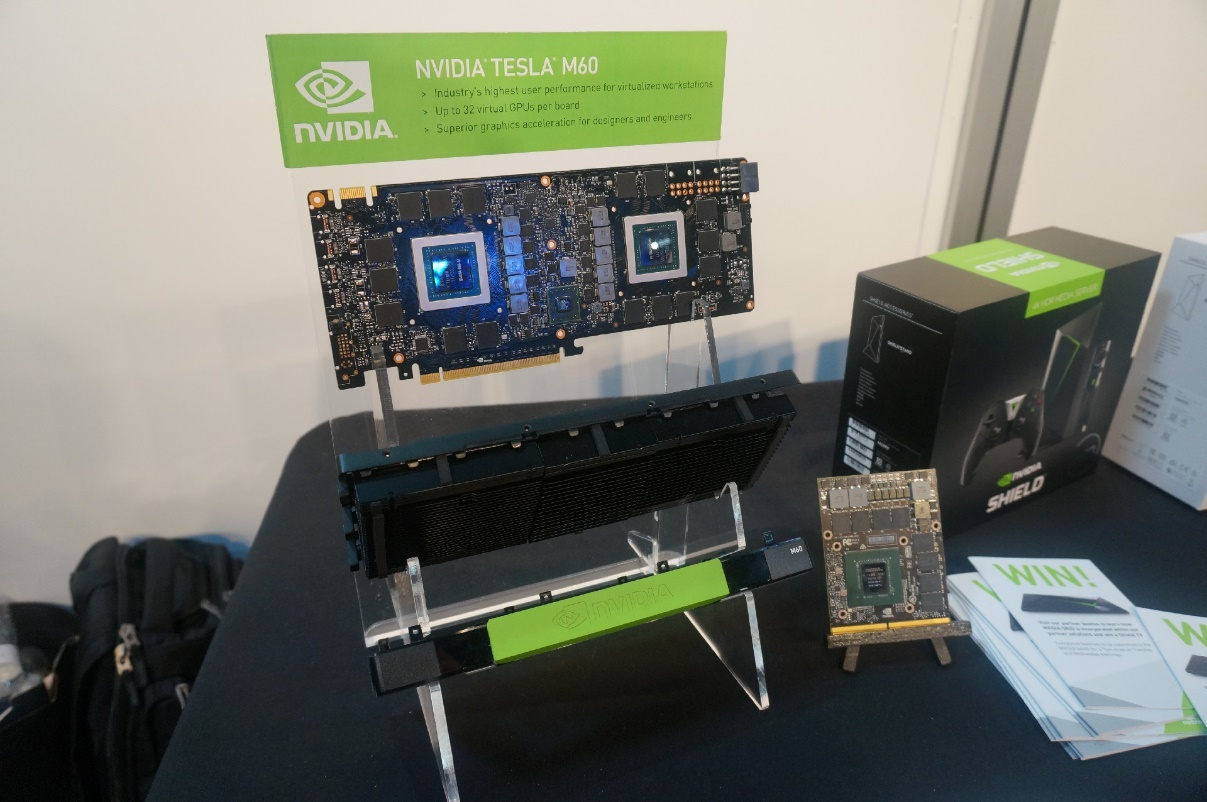
In mid-August, the company announced the upgrade of its GRID solution to version 4.0. The new GRID allows you to use the resources of the graphics adapter of a physical server to speed up graphics processing or resource-intensive computing inside virtual machines.
In addition to graphics processing, accelerators can also be used to reduce the load on the CPU when playing H.264 video or encoding images for the VMware Blast protocol in VDI scenarios, which will increase the density of VMs on a single physical server.
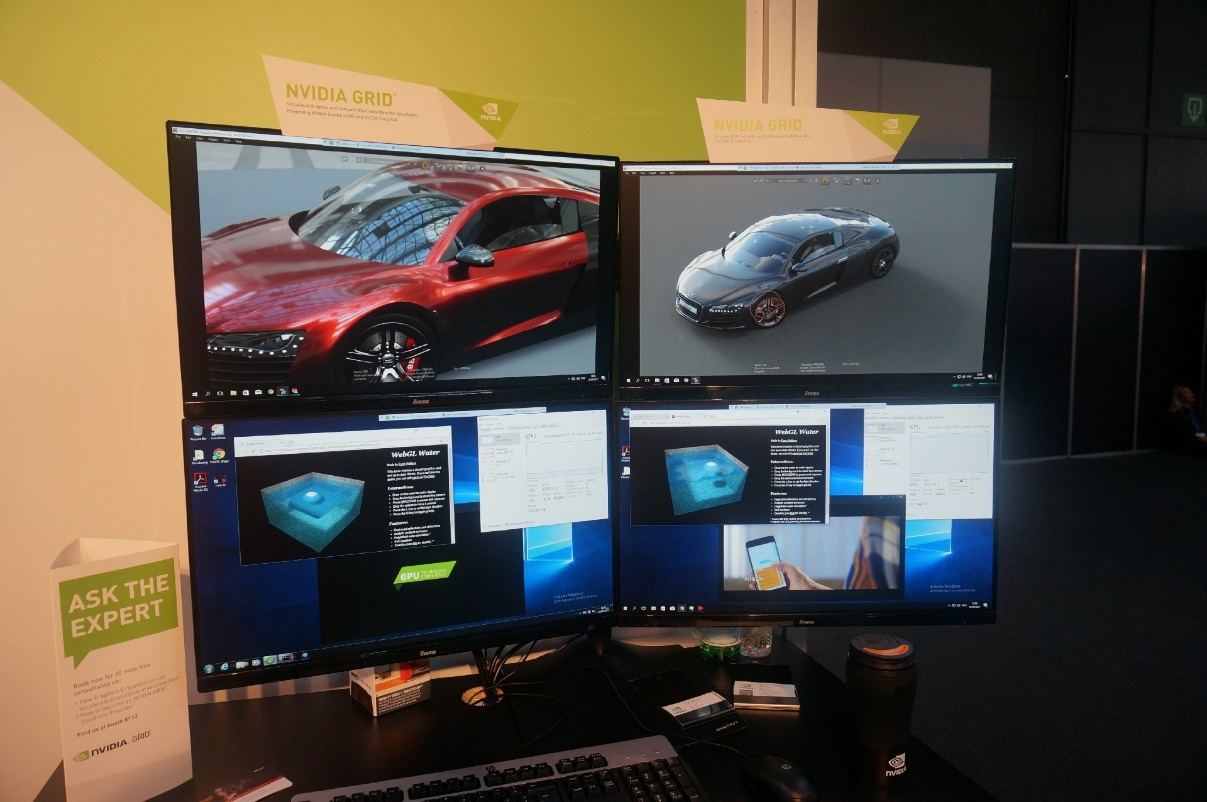
In the new version of GRID, accelerators with the Pascal architecture: P4, P6, P40, and P100 are now supported.
The Tesla P40 accelerator, made in the form factor of a full-sized PCI-E adapter, increases user density by 50% when using profiles with 1 GB of video memory compared to the previous generation Maxwell accelerator (M60). For blade servers, the P6 accelerator is suitable.
A comparison of the main parameters of the accelerators of the current and previous generations is given in the table.
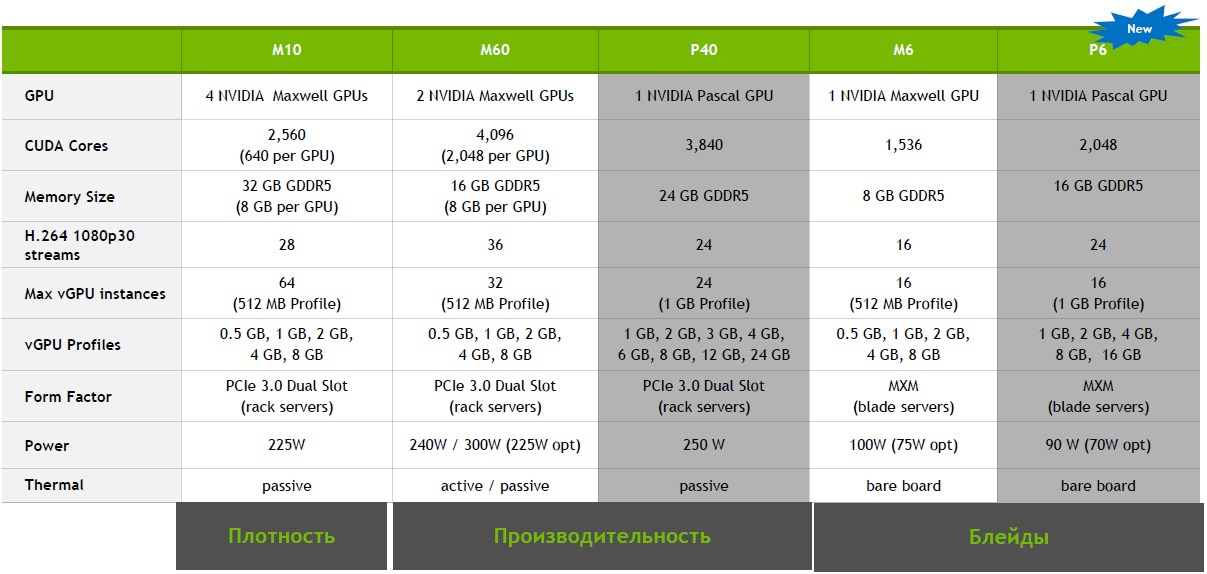
The Tesla P100 accelerator is designed not so much for processing graphics as for accelerating mathematical calculations (CUDA, OpenCL).
But along with a barrel of honey, NVIDIA prepared a small fly in the ointment. For vSGA, vDGA or vGPU to work, additional GRID licenses are required depending on the mode used and the load profile. And if before the server did not check the availability of the necessary licenses, then from now on in the absence of a license the accelerator will refuse to work and switch the VM to use a virtual GPU.
AMD and Dell organized a joint booth inside a large trailer, which presented the functionality of the new EPYC processors and servers based on them.
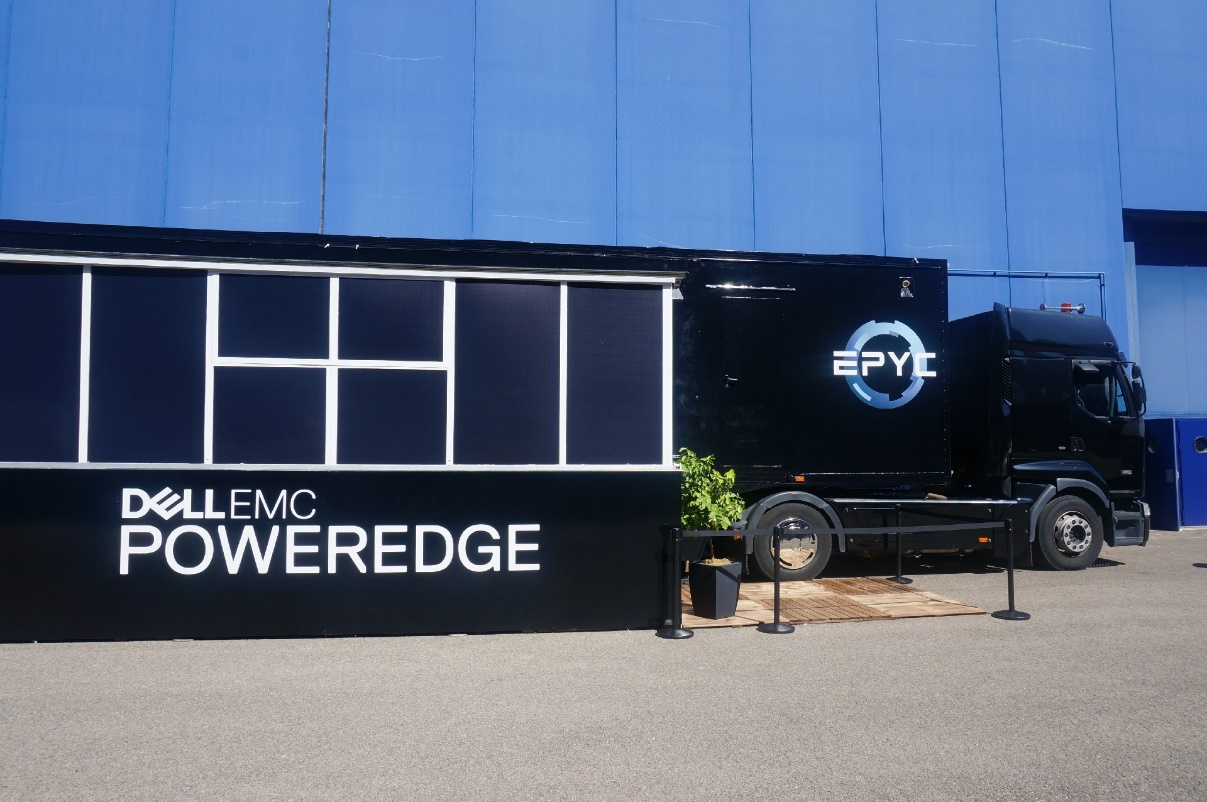
The screens showed various load scenarios: virtualization, DBMS, HPC computing. On separate load profiles, the advantage of the new EPYC over Intel processors can reach 30%. The main differences between AMD and Intel processors are shown in the table.
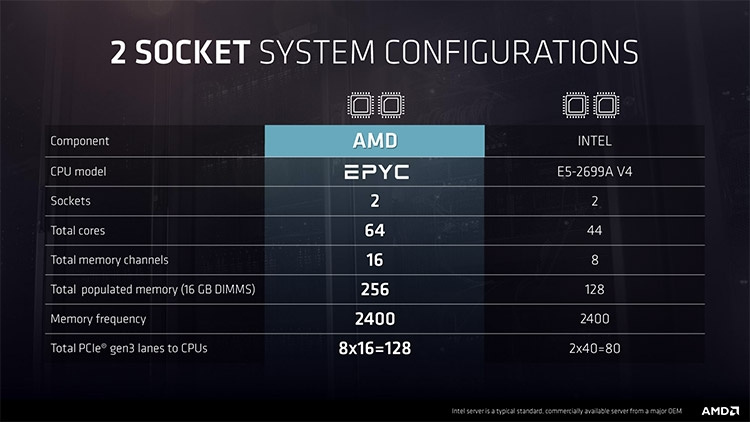
Also at the booth was a new Dell PowerEdge R7415 2U server (it could only be viewed close after signing the NDA), with SR3 sockets (aka TR4). Structurally, the server is similar to its relatives R730xd and R740, however, it has a number of design features that cannot yet be disclosed. The release of Dell servers with AMD EPYC processors is expected in December-January.
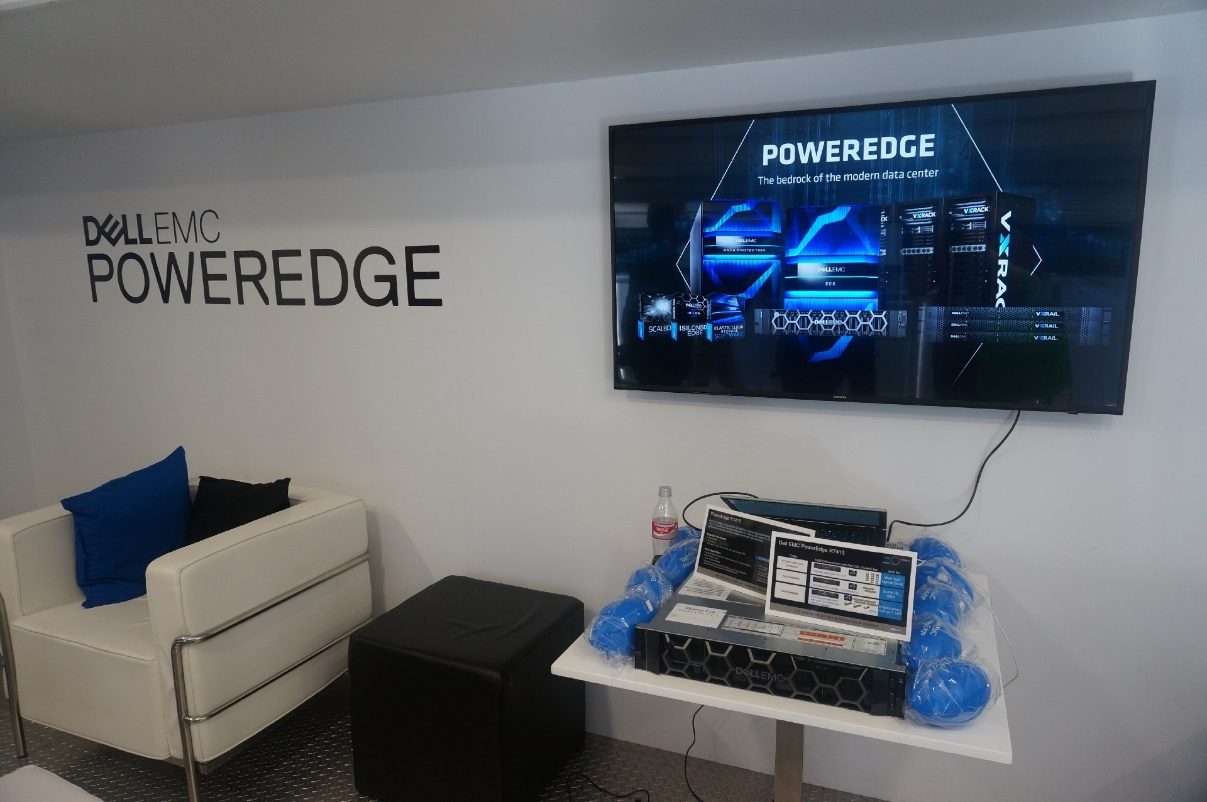
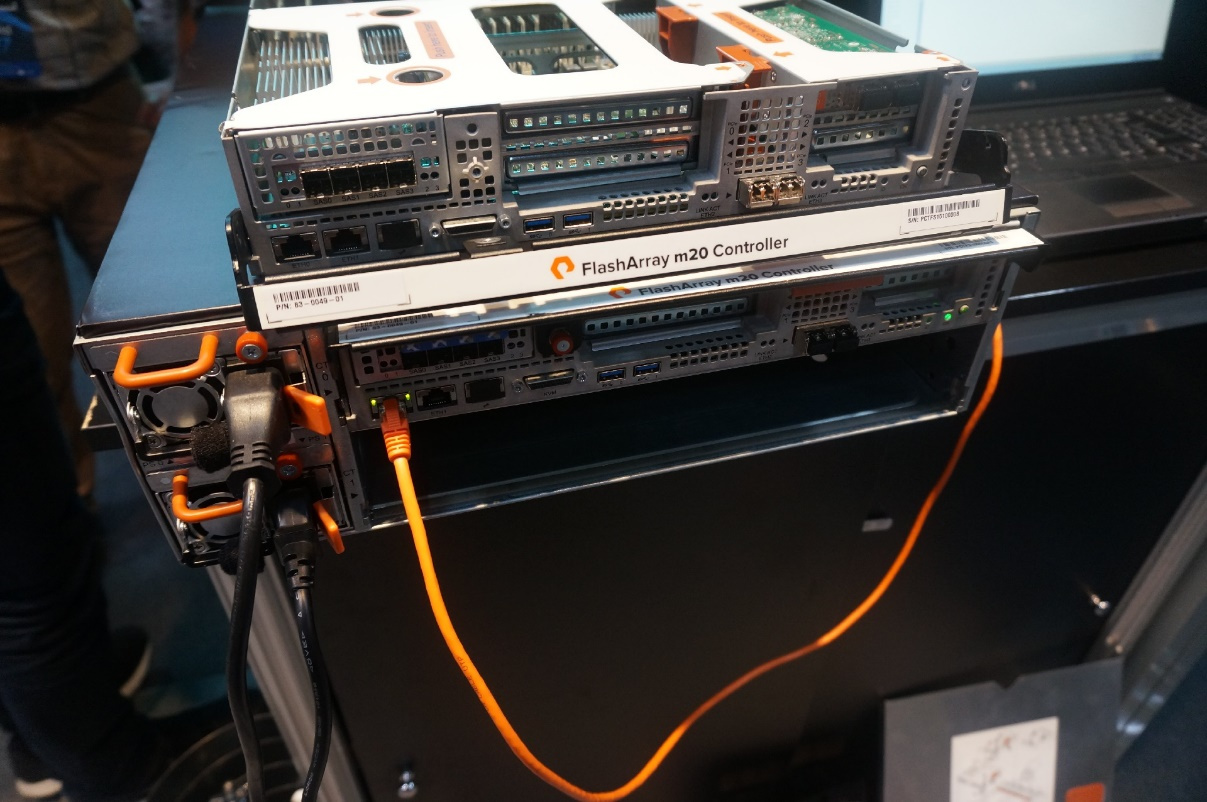
At the booth of the new Jet Infosystems partner, Pure Storage (a leading manufacturer of All-Flash storage systems, according to Gartner analytic agency), the FlashArray // m20 model was demonstrated. Pure Storage storage systems have all the features for which customers love AFA arrays, while all functions are included in the base cost of the array and do not require the purchase of additional licenses or extension packs. You can read more about FlashArray // m20 in our publications: 1 , 2 .
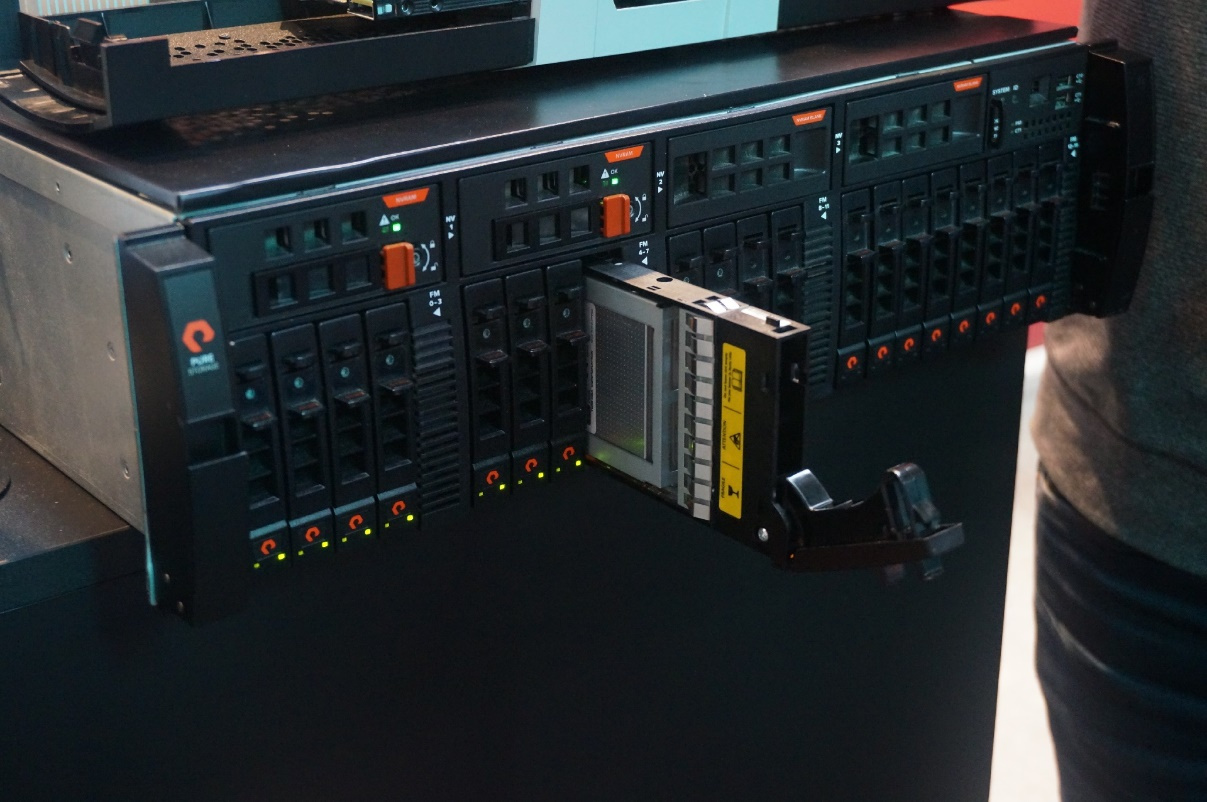
What sets Pure Storage arrays apart from competing solutions is the EverGreen service. Customers are offered a fundamentally new model of product ownership - “subscription to innovation”. During the service contract, all new array software functions are provided to customers free of charge, and every three years the manufacturer replaces the outdated controllers with modern ones. Any upgrades, including the transition to the next generation of controllers, are made on the go and do not require re-acquisition of capacity. In addition, when selling an array, Pure Storage conducts a survey and guarantees a certain level of savings in data storage (data reduction) through the use of compression and deduplication; in case of impossibility to achieve guaranteed performance, the vendor increases the array capacity for free.

My attention was drawn to the stand of another manufacturer of storage systems - Infinidat. This is the brainchild of Moshe Yanai, who in the 1990s participated in the development of EMC Symmetrix arrays, and also founded the XIV company, which produced the arrays of the same name and later bought by IBM.
InfiniBox storage systems that belong to the class of unified storage systems supporting Fiber Channel, FICON, iSCSI and NFS protocols and designed to store a large amount of data (from 115 TB in the junior F1000 model to 2.7+ PB in the older F6000 model were demonstrated at the stand excluding compression) with an extremely high level of availability of 99.99999% (no more than 3.15 seconds of inactivity per year).
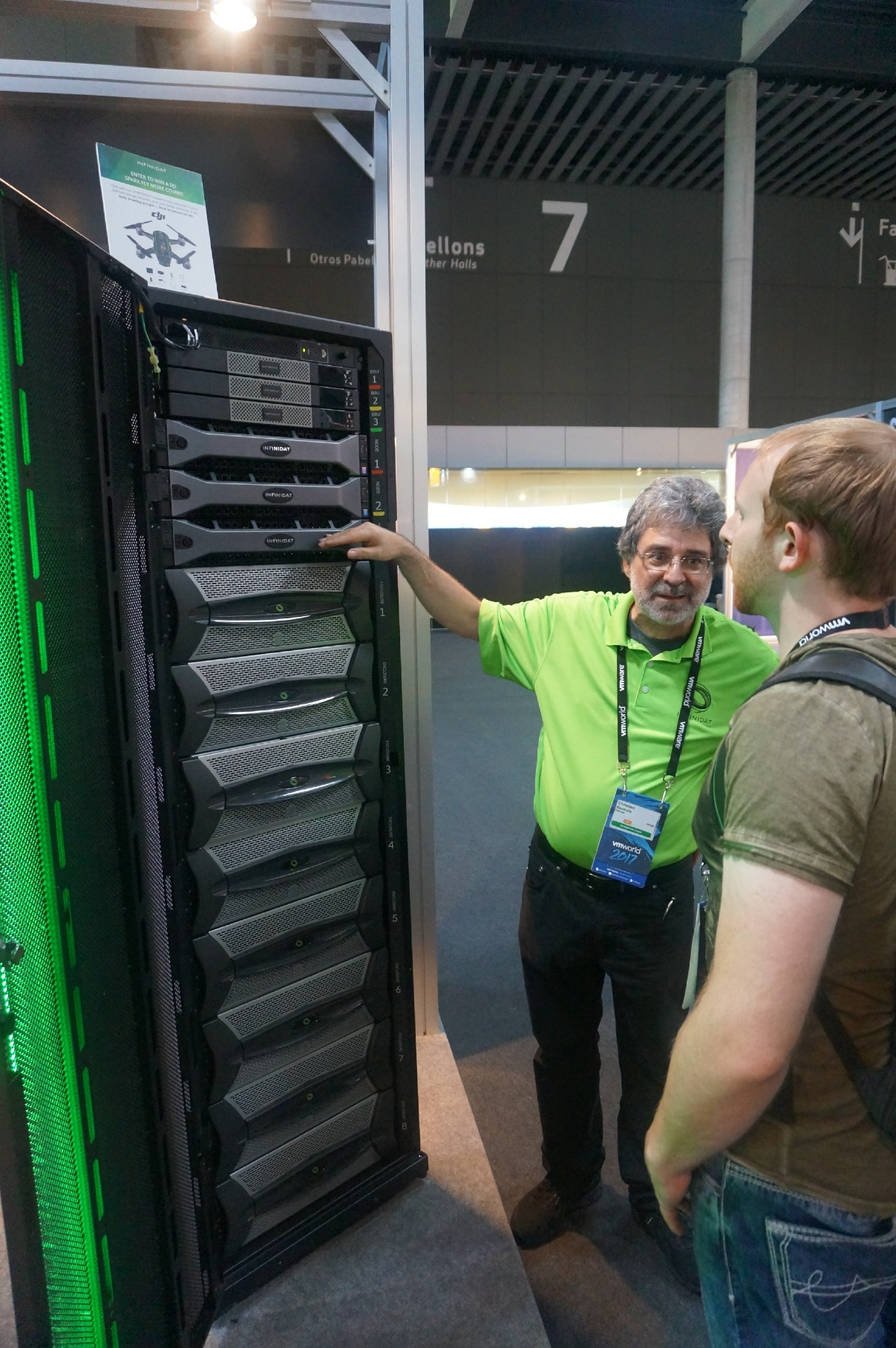
Storage comes pre-assembled and wired in a rack. The architecture is based on three controller servers that connect to each other through the Infiniband network, as well as high-density disk shelves containing NL-SAS disks. A high level of performance (from 300 thousand IOPS in the younger model to 1 million IOPS in the older model) is achieved through multilevel caching on flash drives and in RAM of controllers, as well as by analyzing the nature of I / O and predictive data caching. Storage supports snapshots creation, data replication, in-line compression, integrates with the VMware vSphere Client management interface and can restore individual VMware virtual machines from snapshots of logical volumes without using a backup system.
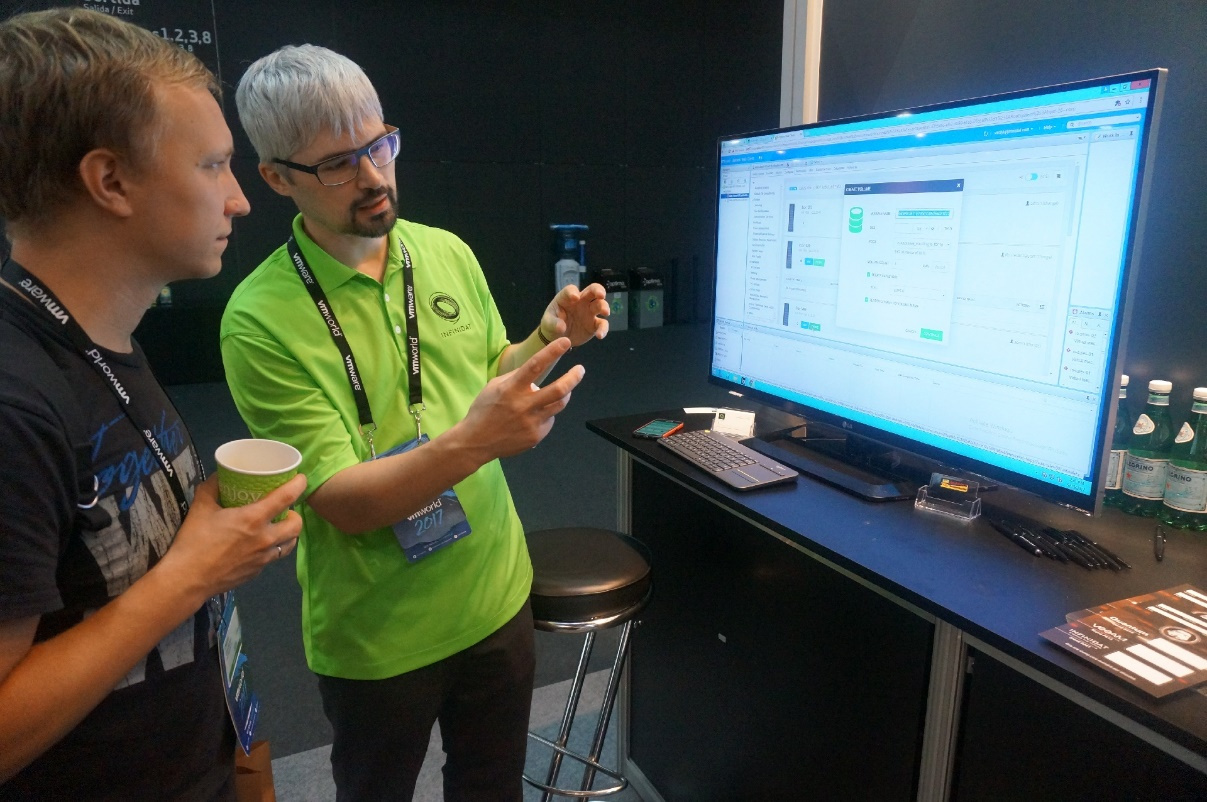
Special mention deserves a visual monitor of indicators of loading and performance, mounted directly in the door of the rack.

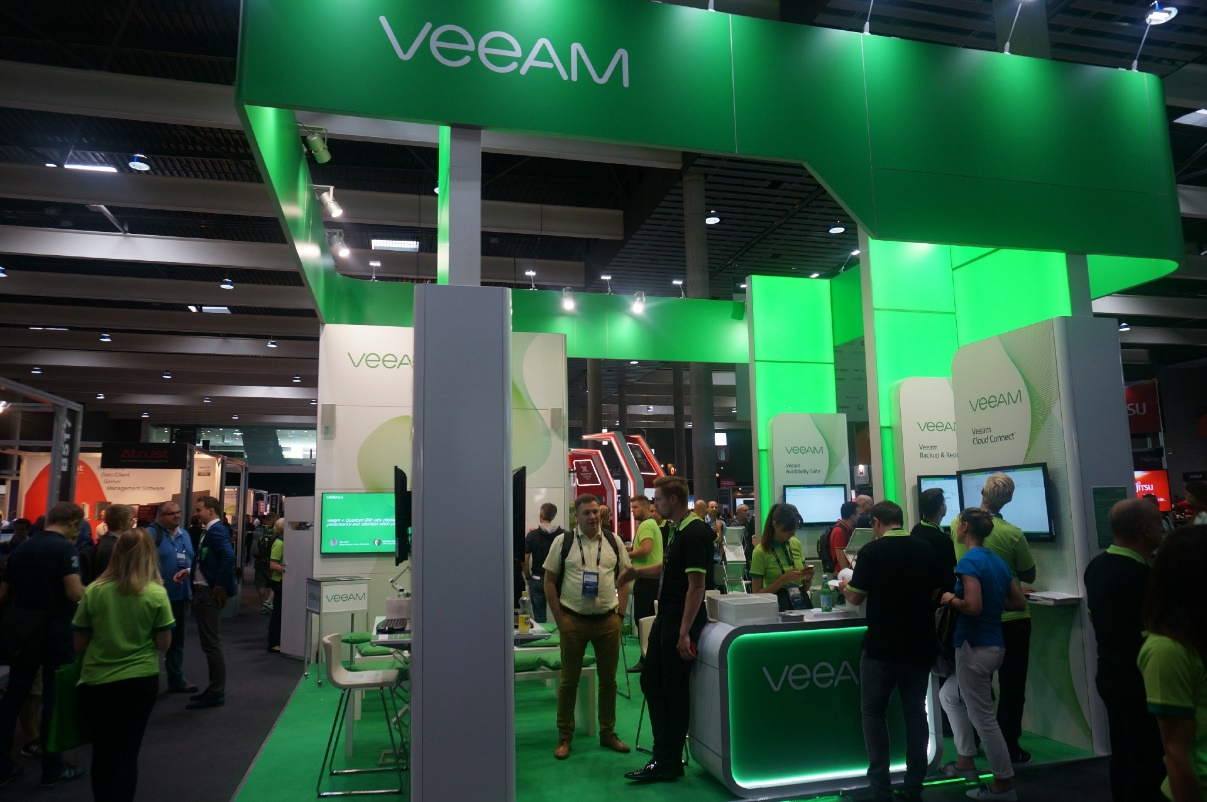
This year, Veeam released version 2.0 of the Veeam Agent backup for Windows and Linux, which allows you to backup and restore not only virtual machines, but also physical workstations and servers. In total, three editions of the product are available: Free, Workstation and Server. Their differences are given in the table.

By the way, the free version of this IBS protects data on my computers and a couple of times helped transfer the operating system and data from old disks to new ones. I am sure that among the readers of Habr there will be many fans of this IBS.
Veeam also announced a new version of its flagship product - Veeam Backup & Replication 10. VBR is the leading solution for backing up and restoring virtual infrastructures based on VMware vSphere and Microsoft Hyper-V.
Key innovations:
The release of VBR 10 is expected this winter.
Nutanix, one of the market leaders in HCI solutions, has honored visitors with a rather modest booth this year. This is understandable, this year the vendor holds Nutanix .NEXT in France, so he has all the main announcements for his conference. Nevertheless, I managed to learn something interesting.
Firstly, the company is preparing to release its own Nutanix CALM orchestration and automation tool, based on Calm.io startup solutions purchased last year.
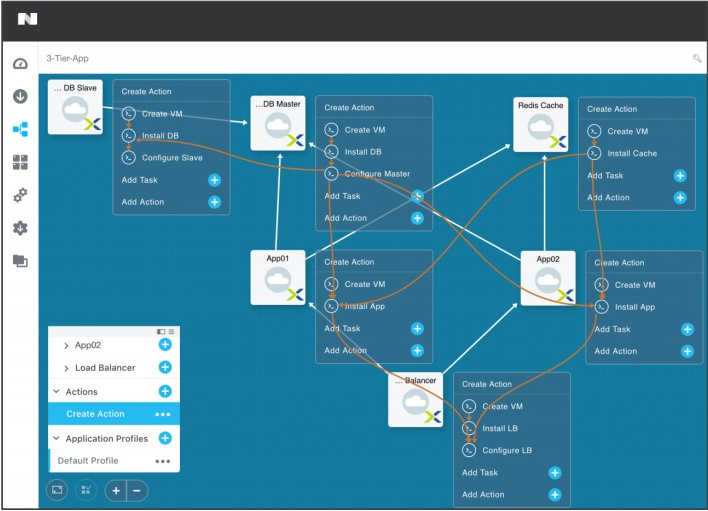
Nutanix CALM provides a self-service portal with which users can launch various actions - from creating a new VM or container in the on-premise infrastructure or cloud to deploying a multi-tier application that includes database servers, application servers and balancers. Using a simple and intuitive graphical interface, administrators can independently create new templates that perform certain operations.
Secondly, we are waiting for a new version of the hyperconverged platform built on servers with Intel Xeon Scalable processors, as well as a new version of Nutanix software that supports the following functions:
For most users familiar with QNAP products, this vendor is associated with NAS devices designed for the SOHO segment (small office, home office). However, the product catalog also contains very interesting entry-level multiprotocol storage systems. For example, QNAP ES1640dc v2.

The QES operating system (based on FreeBSD) is installed on the storage system; ZFS is used as the file system. The storage system supports data access protocols CIFS / SMB2 / SMB3, NFS v3 / NFS v4, FTP, FTPS, TFTP and iSCSI, integrates with virtual infrastructure, including VAAI support, and has an agent for integration with VMware SRM.
Hardware Specifications of ES1640dc v2:
A nice bonus: QNAP does not oblige customers to purchase “their own” components, but instead publishes HCL lists of compatible drives and SSDs manufactured by Seagate, HGST, Toshiba, Micron, equipping storage systems with the necessary slides for their installation.
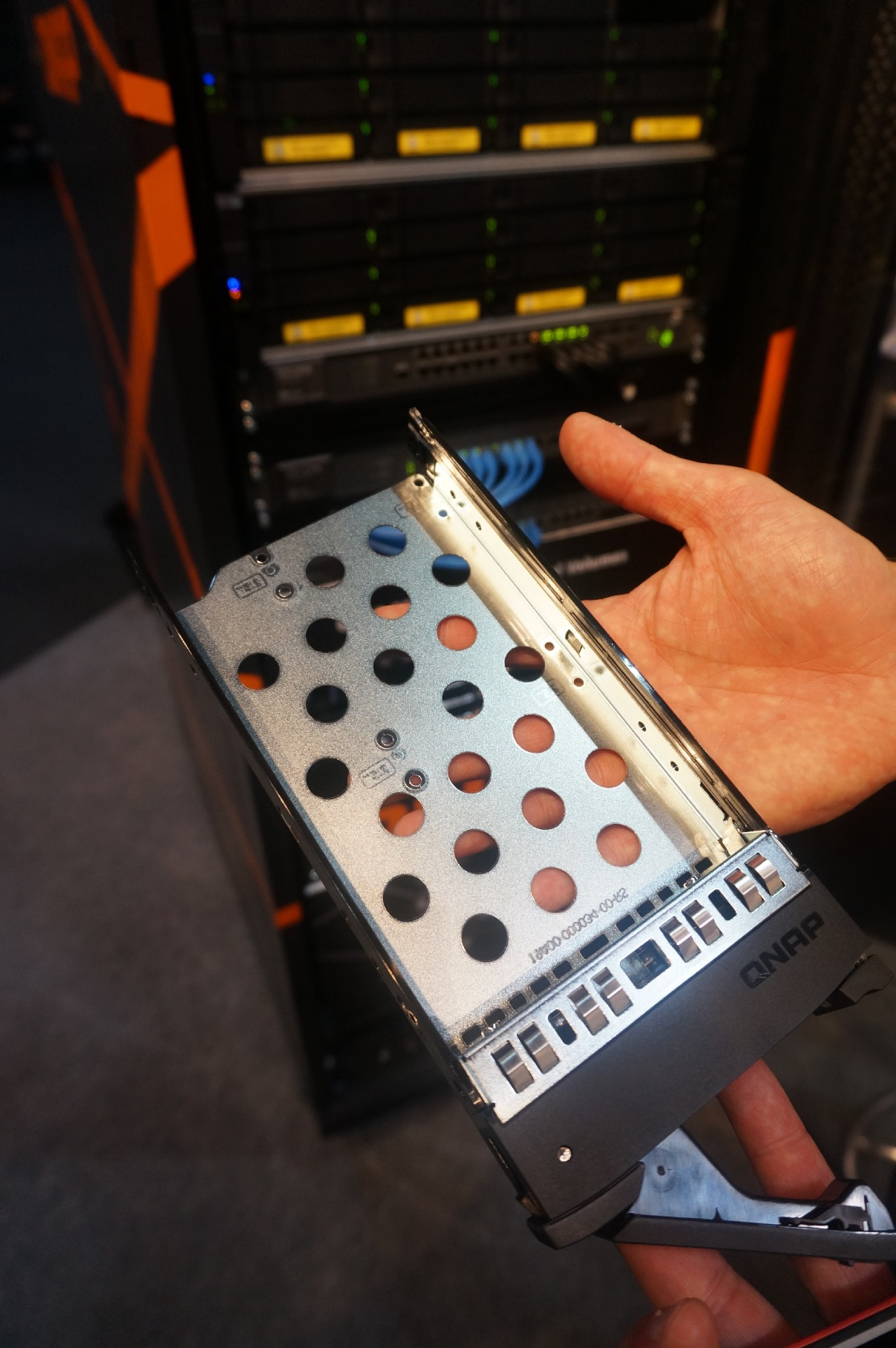
Given the functionality and low price, this model can be a good alternative to popular entry-level storage systems like the HPE MSA 1040/2040 or NetApp E2700.
Atrust, one of the manufacturers of thin clients for connecting to terminal farms and VDI infrastructures, offers a wide range of products: from typical devices with Windows Embedded or Linux OS to zero clients based on Teradici processors, as well as thin clients made in the form factor monoblocks and laptops.
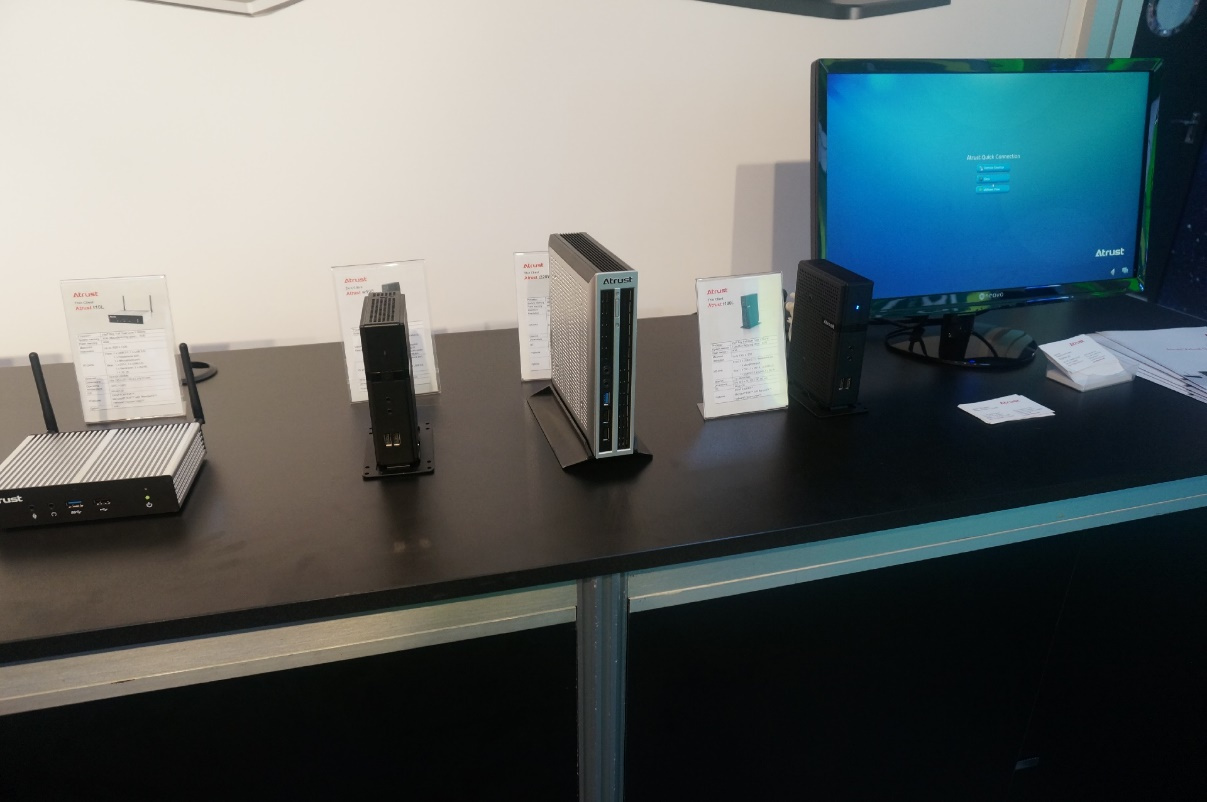
Atrust booth demonstrated a new product - Atrust P2T software (PC to Thin Client). P2T is functionally identical to Atrust OS installed on the TC and is an optimized Linux distribution that includes a set of drivers, the main clients for remote connection (VMware Horizon Client, Citrix Receiver, Microsoft RDP), as well as an agent for integration with the Atrust Device Manager server, which allows centrally manage devices, distribute settings, install OS updates and monitor devices.
This solution may be interesting for customers planning to switch to VDI, having a fleet of functioning computers and not ready to pay for new thin clients. Using P2T, you can turn existing computers into thin clients by installing the OS on a hard drive or booting from an external USB drive.
The last solution I want to talk about is the software for backing up virtual environments - Nakivo Backup & Replication.
Perhaps some of you have already read the article on Habré , for the rest I will briefly talk about this decision.
Nakivo Backup & Replication supports most of the features that you would expect from entry-level virtual environments.
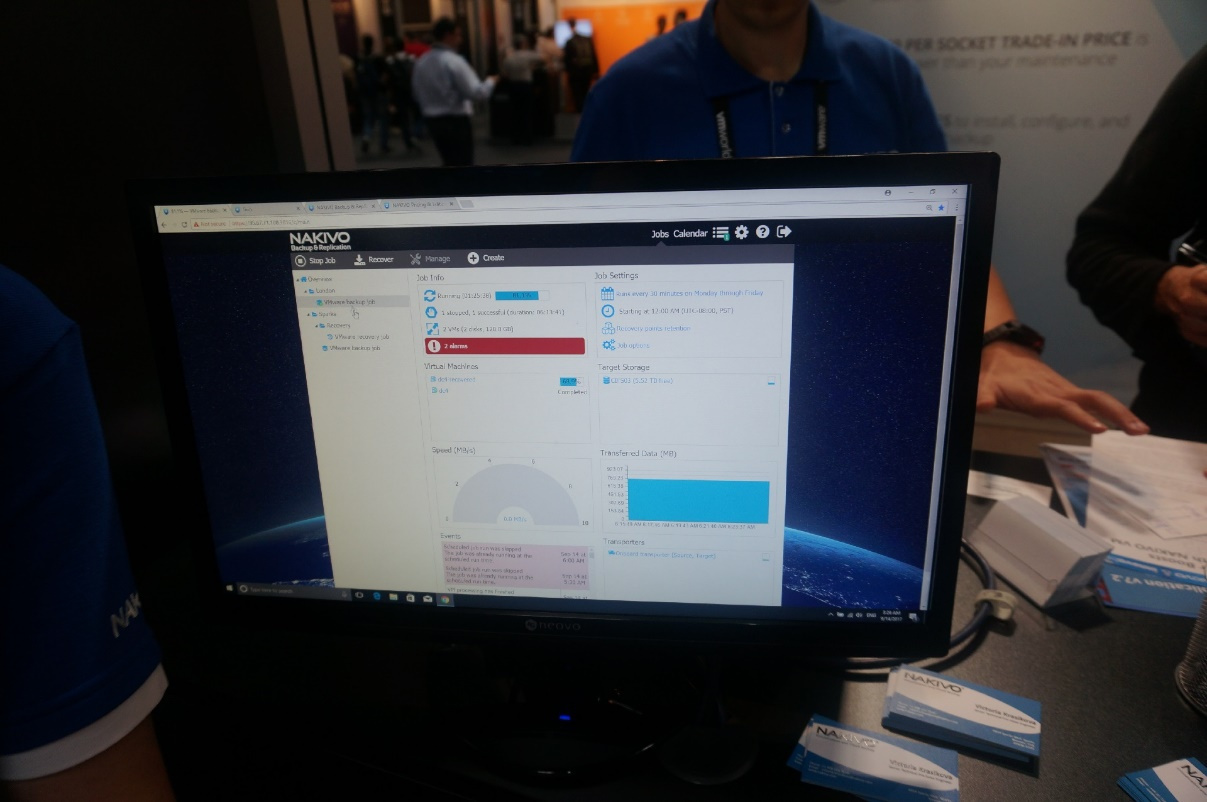
Nakivo also has a unique feature that is not available in other IBS solutions: the ability to install directly into NAS-storages manufactured by QNAP, Synology, ASYSTOR or WD, which allows you to organize an economical backup and storage solution for backups for small offices and branches.
Although Nakivo Backup & Replication does not have the full functionality of other IBSs, such as Veeam Backup & Replication, Veritas Backup Exec or others, the solution is focused on the SMB segment and attracts with its low price.
At the stand of Rubrik, a manufacturer of software and hardware solutions for backups, a VMware vSphere 6.5 Host Resources Deep Dive book distribution session was autographed by the authors Frank Denneman and Niels Hagoort. Although I already bought this book in electronic form (and it costs every cent, I highly recommend reading it to all vSphere administrators), I did not fail to take the opportunity to take a paper copy.
With this, our story about the VMware 2017 Europe conference comes to an end. I hope that for someone this information will be useful and interesting.
In the meantime, we have a whole year ahead to try all the products and solutions that were demonstrated at the conference in practice and make our virtual infrastructures even more functional, productive and highly accessible. Thank you for your attention, see you soon!
Andrey Konovalov, Head of Virtualization Department, Jet Infosystems

VMware announcements at the conference
Before proceeding to the description of the exhibition of partner solutions, I want to list the main announcements that were made during the conference VMworld US and Europe.
VMware Workstation 14
The release of VMware Workstation 14 and VMware Workstation Player 14, client hypervisors installed on top of Windows or Linux.

Among the new features:
- support for current versions of guest OSs: Windows 10 Creator Update, Ubuntu 17.04, Fedora 26;
- Secure Boot support for guest OS;
- Virtualization Based Security (VBS) support in Windows 10;
- support for virtual NVMe drives for VMs;
- advanced network settings that allow you to limit bandwidth, emulate delays and packet loss when transmitting data over the network;
- The ability to deploy the VMware vCenter Server Appliance (VCSA) in a Workstation virtual machine
- Advanced ESXi Host Management
- VMware Fusion 10 and Fusion 10 Pro, client hypervisors for MAC OS X, were also announced.
End-of-life VMware vCenter Server for Windows
It is announced that the next version of vSphere (probably vSphere 7.0) will be the last with support for VMware vCenter Server on the Windows platform. The solution is correct and expected, because the functionality of VCSA and vCenter Server for Windows were equal in vSphere 6.0, and in vSphere 6.5, VCSA introduced additional features like the built-in vCenter High Availability mechanism, built-in backup, and vSphere Update Manager update module.
Also, the next version of vSphere will be the last for the vSphere Web Client (Flash-based), which will be replaced by vSphere Client (HTML5).
Last in the drop-out list is vmkLinux, a component that provides ESXi compatibility with Linux drivers. Starting with vSphere 5.5, developers began to provide the so-called native drivers, which provide better performance and stability compared to Linux-drivers. Rejecting vmkLinux potentially means shortening the HCL list of supported servers and peripherals and not being able to run ESXi on your favorite whitebox server with Realtek network adapters.
VMware Integrated OpenStack 4.0
New release of VMware Integrated OpenStack 4.0.

VIO is an OpenStack distribution developed and maintained by VMware. VIO 4.0 is based on the OpenStack Ocata release and offers the following innovations:
- container deployment support;
- integration with the VMware vRealize Automation self-service portal, which allows you to control the installation of OpenStack directly from the vRA interface, as well as create vRA templates (blueprints) containing OpenStack objects;
- the ability to add several vCenter Servers under VIO to increase cloud computing resources;
- additional features, for example, increasing processors or adding memory without turning off the VM, Firewall as a Service functions, and much more.
Unfortunately, VIO 3.1 was the latest version to be provided free of charge to customers who purchased vSphere Enterprise Plus. Starting with VIO 4.0, you need to purchase licenses and SnS support for each socket of virtualization servers that will be managed by VIO.
VMware AppDefense
VMware Introduces New Virtual Environment Security Product - AppDefense.
AppDefense allows you to analyze the behavior of applications (processes) running in the guest OS inside the VM, and based on the data received, set a certain baseline - normal behavior for the VM. In case of deviation from the line of behavior, for example, during the actions of malicious software, AppDefense can automatically apply one of the following actions to the VM:
- block or restrict the network activity of a suspicious process using VMware NSX,
- turn off or pause the VM,
- create a snapshot for further study, as well as notify the security administrator.
AppDefense can integrate with third-party information security products, such as: IBM Security, RSA, Carbon Black, SecureWorks, expanding the functionality of AppDefense to verify and perform various actions.
VMware vRealize Network Insight 3.5
A new version of vRNI 3.5, a product for solving problems with virtual and physical network infrastructures, has been released. vRNI collects configuration information from virtual and physical switches, routers, and firewalls and provides it in a convenient, visual format that makes it easier to detect network problems. For example, you can trace the entire path of the packet from the VM network interface — through the NSX logical switch, ESXi server uplink, Cisco Nexus switch port, Juniper router, Check Point ITU — to the physical server port.

The following features appeared in the new version of vRNI: checking the network infrastructure for compliance with the PCI DSS standard, support for collecting data from NSX through the IPFIX mechanism, visualizing traffic between VMs passing through routers with ECMP configured, collecting data from additional third-party sources: Check Point Firewall, HP One View, Brocade MLX.
vSphere Integrated Containers
VMware has updated VIC to version 1.2, which allows containers to run directly on VMware ESXi servers.

The main difference between the VMware approach and other container managers is that each container runs in a separate instance of the VM. Thus, administrators are able to manage containers in the same way as VMs, using the benefits of a virtualization platform such as better isolation, the ability to move containers from host to host, control container network connectivity using VMware NSX, monitor containers using vRealize Operations Manager, and much more. . To reduce the overhead of launching containers, Instant Clone technology is used, which allows you to create copies of working VMs in real time using the Transparent Pages Sharing and Linked Clones mechanisms to save RAM and disk space.
Among the innovations:
- user authentication and authorization support, including SSO integration with VMware Platform Service Controller server;
- integration of the VIC Registry management interface and the management portal;
- the ability to change parameters (number of processors, amount of RAM) of virtual hosts on which containers are running (Virtual Container Host) without re-creating;
- full support for the Docker Engine, support for commit, diff, stats, cp commands in the CLI.
vRealize LifeCycle Manager
VMware announced a new version of vRealize Suite 2017, which included products such as vRealize Automation 7.3, vRealize Business 7.3, vRealize Operationss 6.6, as well as a new product - vRealize LifeCycle Manager.
Those with experience deploying vRealize Suite know this is not easy. vRealize LifeCycle Manager solves the problems of deploying and updating the above products with just the click of a button, and also allows you to check existing installations for compliance with the best practices of the vendor.
Exhibition Exchange Solutions
During the conference on the exhibition, excursions were arranged for visitors from Russia and the CIS countries. Evgeny Garbuzov (pictured left), a systems engineer from the VMware branch in Russia, showed the most interesting stands and answered all kinds of tricky questions.

NVIDIA booth
At the NVIDIA booth, accelerators of the Maxwell and Pascal generations were demonstrated.

In mid-August, the company announced the upgrade of its GRID solution to version 4.0. The new GRID allows you to use the resources of the graphics adapter of a physical server to speed up graphics processing or resource-intensive computing inside virtual machines.
In addition to graphics processing, accelerators can also be used to reduce the load on the CPU when playing H.264 video or encoding images for the VMware Blast protocol in VDI scenarios, which will increase the density of VMs on a single physical server.

In the new version of GRID, accelerators with the Pascal architecture: P4, P6, P40, and P100 are now supported.
The Tesla P40 accelerator, made in the form factor of a full-sized PCI-E adapter, increases user density by 50% when using profiles with 1 GB of video memory compared to the previous generation Maxwell accelerator (M60). For blade servers, the P6 accelerator is suitable.
A comparison of the main parameters of the accelerators of the current and previous generations is given in the table.

The Tesla P100 accelerator is designed not so much for processing graphics as for accelerating mathematical calculations (CUDA, OpenCL).
But along with a barrel of honey, NVIDIA prepared a small fly in the ointment. For vSGA, vDGA or vGPU to work, additional GRID licenses are required depending on the mode used and the load profile. And if before the server did not check the availability of the necessary licenses, then from now on in the absence of a license the accelerator will refuse to work and switch the VM to use a virtual GPU.
AMD Truck Stand
AMD and Dell organized a joint booth inside a large trailer, which presented the functionality of the new EPYC processors and servers based on them.

The screens showed various load scenarios: virtualization, DBMS, HPC computing. On separate load profiles, the advantage of the new EPYC over Intel processors can reach 30%. The main differences between AMD and Intel processors are shown in the table.

Also at the booth was a new Dell PowerEdge R7415 2U server (it could only be viewed close after signing the NDA), with SR3 sockets (aka TR4). Structurally, the server is similar to its relatives R730xd and R740, however, it has a number of design features that cannot yet be disclosed. The release of Dell servers with AMD EPYC processors is expected in December-January.

Pure Storage Booth

At the booth of the new Jet Infosystems partner, Pure Storage (a leading manufacturer of All-Flash storage systems, according to Gartner analytic agency), the FlashArray // m20 model was demonstrated. Pure Storage storage systems have all the features for which customers love AFA arrays, while all functions are included in the base cost of the array and do not require the purchase of additional licenses or extension packs. You can read more about FlashArray // m20 in our publications: 1 , 2 .

What sets Pure Storage arrays apart from competing solutions is the EverGreen service. Customers are offered a fundamentally new model of product ownership - “subscription to innovation”. During the service contract, all new array software functions are provided to customers free of charge, and every three years the manufacturer replaces the outdated controllers with modern ones. Any upgrades, including the transition to the next generation of controllers, are made on the go and do not require re-acquisition of capacity. In addition, when selling an array, Pure Storage conducts a survey and guarantees a certain level of savings in data storage (data reduction) through the use of compression and deduplication; in case of impossibility to achieve guaranteed performance, the vendor increases the array capacity for free.

Infinidat booth
My attention was drawn to the stand of another manufacturer of storage systems - Infinidat. This is the brainchild of Moshe Yanai, who in the 1990s participated in the development of EMC Symmetrix arrays, and also founded the XIV company, which produced the arrays of the same name and later bought by IBM.
InfiniBox storage systems that belong to the class of unified storage systems supporting Fiber Channel, FICON, iSCSI and NFS protocols and designed to store a large amount of data (from 115 TB in the junior F1000 model to 2.7+ PB in the older F6000 model were demonstrated at the stand excluding compression) with an extremely high level of availability of 99.99999% (no more than 3.15 seconds of inactivity per year).

Storage comes pre-assembled and wired in a rack. The architecture is based on three controller servers that connect to each other through the Infiniband network, as well as high-density disk shelves containing NL-SAS disks. A high level of performance (from 300 thousand IOPS in the younger model to 1 million IOPS in the older model) is achieved through multilevel caching on flash drives and in RAM of controllers, as well as by analyzing the nature of I / O and predictive data caching. Storage supports snapshots creation, data replication, in-line compression, integrates with the VMware vSphere Client management interface and can restore individual VMware virtual machines from snapshots of logical volumes without using a backup system.

Special mention deserves a visual monitor of indicators of loading and performance, mounted directly in the door of the rack.

Veeam booth

This year, Veeam released version 2.0 of the Veeam Agent backup for Windows and Linux, which allows you to backup and restore not only virtual machines, but also physical workstations and servers. In total, three editions of the product are available: Free, Workstation and Server. Their differences are given in the table.

By the way, the free version of this IBS protects data on my computers and a couple of times helped transfer the operating system and data from old disks to new ones. I am sure that among the readers of Habr there will be many fans of this IBS.
Veeam also announced a new version of its flagship product - Veeam Backup & Replication 10. VBR is the leading solution for backing up and restoring virtual infrastructures based on VMware vSphere and Microsoft Hyper-V.
Key innovations:
- Support Veeam Continuous Data Protectionusing vSphere API for I / O filtering technology, which allows virtually synchronous replication of virtual machine data to a backup physical server or storage. Almost all modern data replication tools for virtual environments use the asynchronous data transfer method and the VMware snapshot creation mechanism. This approach has several disadvantages. Firstly, high RPOs, which reach 5 minutes or more, which may be unacceptable for highly critical VMs. Secondly, the use of VMware snapshots leads to a decrease in VM performance. Using CDP, you can broadcast all the recording operations to a special CDP proxy server in real time, which will accumulate and cache them, and then transfer them to the target server. This approach will allow you to restore the VM for any time interval - from a few seconds to a couple of hours of failure. VSS snapshots can be used to ensure data consistency within a VM.

- Full support for Veeam Backup Agents . The VBR server allows you to centrally install agents on workstations and servers, configure backup policies and restore data. Dynamic groups based on Active Directory objects are supported, allowing you to install agents and back up computers that are located in a specific organizational unit or are included in a specific group.
- Ability to backup network folders . A feature that users have been waiting for since many storage infrastructures use dedicated NAS devices. VBR can store the history of all modified files, as well as deleted files for a certain period of time.
- Archival repositories . VBR can automatically move or copy old backups to archive storage to save disk space or provide additional backup security. Administrators can configure different archiving options - for example, move backups older than X days, or move backups only when the main storage is more than X percent full, move only weekly copies, and so on. Archive storage can be Swift, Amazon S3, Amazon Glacier, or Microsoft Azure Blob.
- Extension of the role model . VBR can view the rights that were assigned to users in vSphere, and display only those VMs for backup and recovery to which users have rights.
- Support RMAN plugin for consistent database backup Oracle.
The release of VBR 10 is expected this winter.
Nutanix booth
Nutanix, one of the market leaders in HCI solutions, has honored visitors with a rather modest booth this year. This is understandable, this year the vendor holds Nutanix .NEXT in France, so he has all the main announcements for his conference. Nevertheless, I managed to learn something interesting.
Firstly, the company is preparing to release its own Nutanix CALM orchestration and automation tool, based on Calm.io startup solutions purchased last year.

Nutanix CALM provides a self-service portal with which users can launch various actions - from creating a new VM or container in the on-premise infrastructure or cloud to deploying a multi-tier application that includes database servers, application servers and balancers. Using a simple and intuitive graphical interface, administrators can independently create new templates that perform certain operations.
Secondly, we are waiting for a new version of the hyperconverged platform built on servers with Intel Xeon Scalable processors, as well as a new version of Nutanix software that supports the following functions:
- Near-Sync Replication — новый механизм репликации данных между системами, расположенными на разных площадках, с использованием легких снапшотов (LWS — lightweight snapshots), который позволит уменьшить интервал асинхронной репликации отдельных ВМ и гарантировать RPO вплоть до 1 минуты.
- Встроенное программное шифрование данных без необходимости использования Self-encrypted drives.
- Поддержка режима проброса графических адаптеров vGPU для собственного гипервизора AHV.
- Поддержка гипервизора Microsoft Hyper-V 2016.
- Tech preview-версия встроенного распределенного межсетевого экрана, позволяющего фильтровать трафик между ВМ (микросегментация).
- И многое другое.
Стенд QNAP
For most users familiar with QNAP products, this vendor is associated with NAS devices designed for the SOHO segment (small office, home office). However, the product catalog also contains very interesting entry-level multiprotocol storage systems. For example, QNAP ES1640dc v2.

The QES operating system (based on FreeBSD) is installed on the storage system; ZFS is used as the file system. The storage system supports data access protocols CIFS / SMB2 / SMB3, NFS v3 / NFS v4, FTP, FTPS, TFTP and iSCSI, integrates with virtual infrastructure, including VAAI support, and has an agent for integration with VMware SRM.
Hardware Specifications of ES1640dc v2:
- two controllers based on Intel Xeon E5-2400 v2 processors operating in active-active or active-passive mode.
- до 64 Гб ОЗУ на контроллер и до 16 Гб кэш-памяти на запись с батареей для защиты от пропадания питания.
- 16 отсеков для установки 12G SAS-накопителей с возможностью расширения путем подключения дополнительных корзин по интерфейсам HD-SAS.
- 4 порта SFP+ 10G Ethernet и 2 порта RJ-45 1G Ethernet на каждый контроллер + PCI-E слоты расширения для установки дополнительных адаптеров ввода-вывода.
- два блока питания с поддержкой горячей замены.
A nice bonus: QNAP does not oblige customers to purchase “their own” components, but instead publishes HCL lists of compatible drives and SSDs manufactured by Seagate, HGST, Toshiba, Micron, equipping storage systems with the necessary slides for their installation.

Given the functionality and low price, this model can be a good alternative to popular entry-level storage systems like the HPE MSA 1040/2040 or NetApp E2700.
Atrust booth
Atrust, one of the manufacturers of thin clients for connecting to terminal farms and VDI infrastructures, offers a wide range of products: from typical devices with Windows Embedded or Linux OS to zero clients based on Teradici processors, as well as thin clients made in the form factor monoblocks and laptops.

Atrust booth demonstrated a new product - Atrust P2T software (PC to Thin Client). P2T is functionally identical to Atrust OS installed on the TC and is an optimized Linux distribution that includes a set of drivers, the main clients for remote connection (VMware Horizon Client, Citrix Receiver, Microsoft RDP), as well as an agent for integration with the Atrust Device Manager server, which allows centrally manage devices, distribute settings, install OS updates and monitor devices.
This solution may be interesting for customers planning to switch to VDI, having a fleet of functioning computers and not ready to pay for new thin clients. Using P2T, you can turn existing computers into thin clients by installing the OS on a hard drive or booting from an external USB drive.
Nakivo booth
The last solution I want to talk about is the software for backing up virtual environments - Nakivo Backup & Replication.
Perhaps some of you have already read the article on Habré , for the rest I will briefly talk about this decision.
Nakivo Backup & Replication supports most of the features that you would expect from entry-level virtual environments.
- The ability to backup and restore VMs hosted on VMware vSphere, Microsoft Hyper-V, and Amazon AWS cloud virtualization platforms.
- Support for LAN-Free VM backups (Hot-Add and Direct SAN Backup modes).
- Consistent backup and granular data recovery inside VM: files, Microsoft Exchange mailboxes, Microsoft SQL database and Active Directory objects.
- Функция Instant recover, позволяющая запустить ВМ прямо из бекапа, подключив его в виде логического устройства к серверу виртуализации по протоколу iSCSI. Запущенную таким образом ВМ можно восстановить за секунды и затем перенести в постоянное хранилище, используя функцию Storage vMotion.
- СРК управляется через простой и интуитивно понятный HTML5 веб-интерфейс.
- Поддержка асинхронной репликации ВМ на серверы на другой площадке для сценариев Disaster Recovery.

Nakivo also has a unique feature that is not available in other IBS solutions: the ability to install directly into NAS-storages manufactured by QNAP, Synology, ASYSTOR or WD, which allows you to organize an economical backup and storage solution for backups for small offices and branches.
Although Nakivo Backup & Replication does not have the full functionality of other IBSs, such as Veeam Backup & Replication, Veritas Backup Exec or others, the solution is focused on the SMB segment and attracts with its low price.
What else was interesting
At the stand of Rubrik, a manufacturer of software and hardware solutions for backups, a VMware vSphere 6.5 Host Resources Deep Dive book distribution session was autographed by the authors Frank Denneman and Niels Hagoort. Although I already bought this book in electronic form (and it costs every cent, I highly recommend reading it to all vSphere administrators), I did not fail to take the opportunity to take a paper copy.
Conclusion
With this, our story about the VMware 2017 Europe conference comes to an end. I hope that for someone this information will be useful and interesting.
In the meantime, we have a whole year ahead to try all the products and solutions that were demonstrated at the conference in practice and make our virtual infrastructures even more functional, productive and highly accessible. Thank you for your attention, see you soon!
Andrey Konovalov, Head of Virtualization Department, Jet Infosystems
